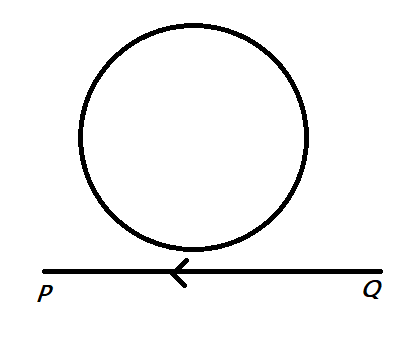
A conducting loop is held above a current carrying wire \[PQ\] as shown below. Depict the direction of current induced in the loop when the current in the wire \[PQ\] is constantly increasing.


Answer
576.3k+ views
Hint: We know that a current carrying conductor can produce magnetic fields around itself. And we also know that current can be produced by a varying magnetic field. The current produced is called induced current and its direction is given by right hand thumb rule.
Complete step by step answer:
We know that a current carrying conductor, here wire \[PQ\] produces a magnetic field around the wire. Then the direction of the magnetic field is given by the write hand thumb rule. According to this, if the right thumb points towards the direction of the current, then the direction of the magnetic field is given by the curled fingers.
Here, consider a point \[A\] inside the circle as shown in the figure below. Then using the right hand thumb rule, we see that the magnetic field lines are pointed inside the paper and denoted by \[\otimes \]

Since the current in the wire \[PQ\] is increasing, this produces a magnetic flux at \[A\].
We also know that a varying magnetic flux can induce current. Thus the circular coil carries induced current due to the magnetic flux. The direction of this current is again given by the right hand thumb rule. Here, point the thumb in the direction of the magnetic field, then the direction of the current is given by the curled fingers. Then the direction of the current is clockwise or as given in the figure below.

Note: That direction of current and the direction of magnetic field are interrelated; when one is given the other can be found using the right hand thumb rule. Also note that the current carrying conductor produces magnetic field and change in magnetic flux produces current.
Complete step by step answer:
We know that a current carrying conductor, here wire \[PQ\] produces a magnetic field around the wire. Then the direction of the magnetic field is given by the write hand thumb rule. According to this, if the right thumb points towards the direction of the current, then the direction of the magnetic field is given by the curled fingers.
Here, consider a point \[A\] inside the circle as shown in the figure below. Then using the right hand thumb rule, we see that the magnetic field lines are pointed inside the paper and denoted by \[\otimes \]

Since the current in the wire \[PQ\] is increasing, this produces a magnetic flux at \[A\].
We also know that a varying magnetic flux can induce current. Thus the circular coil carries induced current due to the magnetic flux. The direction of this current is again given by the right hand thumb rule. Here, point the thumb in the direction of the magnetic field, then the direction of the current is given by the curled fingers. Then the direction of the current is clockwise or as given in the figure below.

Note: That direction of current and the direction of magnetic field are interrelated; when one is given the other can be found using the right hand thumb rule. Also note that the current carrying conductor produces magnetic field and change in magnetic flux produces current.
Recently Updated Pages
Master Class 12 Business Studies: Engaging Questions & Answers for Success

Master Class 12 Economics: Engaging Questions & Answers for Success

Master Class 12 English: Engaging Questions & Answers for Success

Master Class 12 Maths: Engaging Questions & Answers for Success

Master Class 12 Social Science: Engaging Questions & Answers for Success

Master Class 12 Chemistry: Engaging Questions & Answers for Success

Trending doubts
What are the major means of transport Explain each class 12 social science CBSE

Which are the Top 10 Largest Countries of the World?

Draw a labelled sketch of the human eye class 12 physics CBSE

How much time does it take to bleed after eating p class 12 biology CBSE

Explain sex determination in humans with line diag class 12 biology CBSE

Differentiate between homogeneous and heterogeneous class 12 chemistry CBSE




